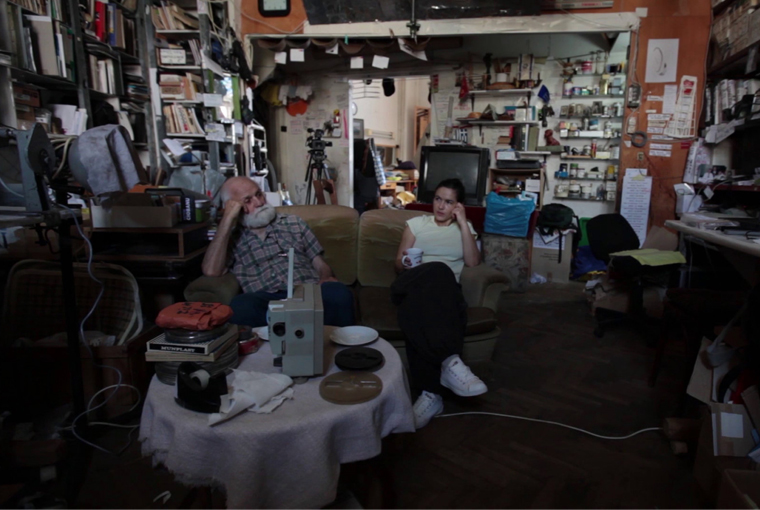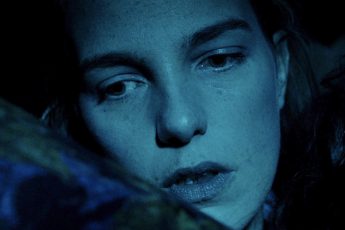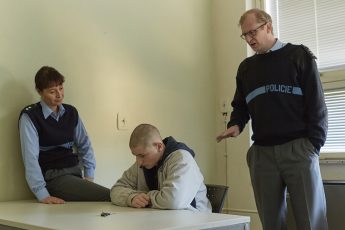
We are introduced to the soundscape of Timebox by the monotonous ticking of a clock, a motif of passing time that will keep returning throughout the film. In her award-winning feature length debut, Nora Agapi creates an intimate portrait of her father, 80-year old photographer and cameraman Ioan-Matei Agapi. Timebox is a poetic documentary dedicated to Agapi senior’s extraordinary life and work; it is simultaneously a reflection on cinema’s perpetual engagement with time, space and memory. The viewer is immersed in a journey through time that not only revives the past, but also aims to keep alive a precarious present doomed to be destroyed.
We are immediately thrown into a flow of images reminiscent of Alan Berliner’s experimental documentary The Family Album (1988), a collage of amateur 16mm home movies, music and audio recordings. Indeed, several homages to Berliner are made throughout Timebox, for instance when a small raven hops through film boxes and negatives in Ioan-Matei Agapi’s apartment, which is situated in the Braunstein Palace, a historic building in the center of Iași. The flat primarily stores his enormous archive with Romania’s largest private collection of 16mm films and photographs.
The film’s opening scene shows Nora and her father next to each other on the couch in his apartment; this historic space is cluttered with manifold boxes in different sizes, technological equipment, paintings and all sorts of collected objects. The entire apartment is an archival treasure box containing not only personal family memories, but also unique documents of half a century of Iași’s history. Timebox juxtaposes footage of the past with present images into a hypnotic stream of time. Watching the film is an immersion into the personal story of Agapi’s life evoked by the particular time-space of his flat and the objects surrounding him. Nora Agapi says her aim was to revive the past of the house. The flat is the space of Nora’s childhood; she grew up here with her father. From the ‘70s onward, professor Agapi would also give film classes in the apartment, which introduced Nora to cinema. In her documentary she thus not only keeps the memory of this specific time-space, but also her initiation to film as a magical process of sculpting time.
In its concreteness, this undertaking never feels forced or abstract, but always personal and touching. Time becomes something tangible and sensual; the memories of professor Agapi’s life are materialized in the space of the flat. Yet, through montage, the film jumps between different periods of time and brings them together in one space. Or as professor Agapi puts it in the film: “Everything is connected in the world. Nothing is singularity.” In one montage, we first see him as a young man, filming himself with a handheld camera in the mirror. This image is then juxtaposed with a shot of him as an old man, again in front of the mirror, with his daughter filming him in the background. „Memory… it fails so easily”, he ponders at one point, and thus verbalizes the transience and unreliability of memory which the film renders visible.
His apartment is a fragile time capsule threatened by its upcoming destruction, which is looming in the background. We learn that professor Agapi has to leave this flat where he has lived for over 40 years. Timebox captures the fading of this reality before its complete disappearance. His life’s work, the archive, becomes a huge burden and the whole situation seems to be a vicious circle with no way out. The walls are crumbling, old family conflicts reemerge, and a different time intrudes. Gradually the ticking of the clock is replaced by the more violent sound of hammers and wrecking balls.
The motif of destruction resurfaces in black-and-white recordings in which the planned demolition of a building is filmed through a window. In one longer sequence, contemporary images of the boulevard in front of Agapi’s house dissolve into archival footage of street scenes, Communist parades, children carrying large paper sunflowers, a car race and a motorcade. At yet another point in the film, a woman wearing a nightdress slowly undresses while gazing directly into the camera, and then seductively lays in bed naked, playing with a corded telephone. The camera vividly lingers over the bed, the woman’s belongings and clothes scattered all over the place. It is an image from a lost era which is then suddenly juxtaposed with a shot of the old Agapi laying in his bed sleeping. Footage from the archive and Nora’s intimate shots of her father create a constant dialogue across different periods of time.
In another scene, professor Agapi is interviewed for television. He and the interviewer are sitting face to face, the atmosphere is uneasy and artificial. The interviewer ponders the relation between philosophy and film and stresses the beauty of creating art with light. Agapi, witty and idiosyncratic as we have already come to know him, suddenly interrupts the program: “Stop, camera, cut!” A close-up on his face, and we see him asking for water and sugar. There is something hilarious in the contrast between the interviewer’s abstract reflections and Agapi’s playful relation to the world. The whole scene ends on a simple and yet philosophical statement by Agapi: “Life itself is a line.” Timebox produces these moments of clarity and simplicity which seem to emerge very naturally from a flow of conversations and images.
Timebox is animated by a deep passion for filmmaking, that alchemistic process of creating, distorting and capturing time. As Agapi and her father reveal through their creative dialog, films (and the archives housing them) are reflections on the construction of memory and history. Indeed, Timebox is acutely aware of its own constructed character. In one of the many self-reflective moments of the film, Agapi plays with the idea of cinematic illusion. Peering through an old viewfinder, Agapi says to his daughter: “Now I see everything upside down.” In cinema too, the world can be turned upside down; the burdens of everyday gravity and reality are thus lifted, if for a moment.
Only gradually do we become aware that the reality we are witnessing in Timebox is a faded world that does not exist anymore. Of course, the film is driven by nostalgia, but its evocation of the past is light and playful rather than grieving. While creating a deeply personal aesthetic language, Timebox also evokes the austere aesthetics of Romanian New wave directors like Cristi Puiu. Through its fusion of a very personal story with rare ethnographic and historical footage, Timebox lends insight into past and present everyday life in Romania.




Leave a Comment